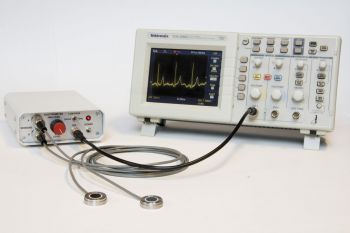One of the earliest application areas to attract interest has been electrophysiological measurement. EP sensors can record high quality data directly off the skin or through clothing without the need for surface preparation or hair removal. This is because the sensors do not need to be resistively coupled to the skin; the measurement is made through a thin insulating layer on the surface of the sensor. This offers several advantages over both conventional ‘wet electrode’ and resistive ‘dry electrode’ techniques. Wet electrodes can dry out if worn for long periods of time and dry electrodes may suffer from variations in sensitivity when sweat is present.
 Prototype ECG demonstration unit developed at Sussex
Prototype ECG demonstration unit developed at Sussex
This combination of properties makes EPS ideal for use in telehealth/homehealth and sports applications where unobtrusive wearable sensors, which may be use effectively by untrained staff, are required. To date 20 of these demonstration units have been trialled by commercial organisations worldwide. These units are now being manufactured by our industrial partners Plessey Semiconductors.
Our fundamental research aim is to use this work as the basis for a high density multi-element imaging array capable of producing a real-time electro-dynamic map of the heart. Such an instrument could be integrated with data from functional MRI in order to enable a much more accurate assessment of heart muscle function to be realised.
For further information regarding this research, please contact Dr Helen Prance.


